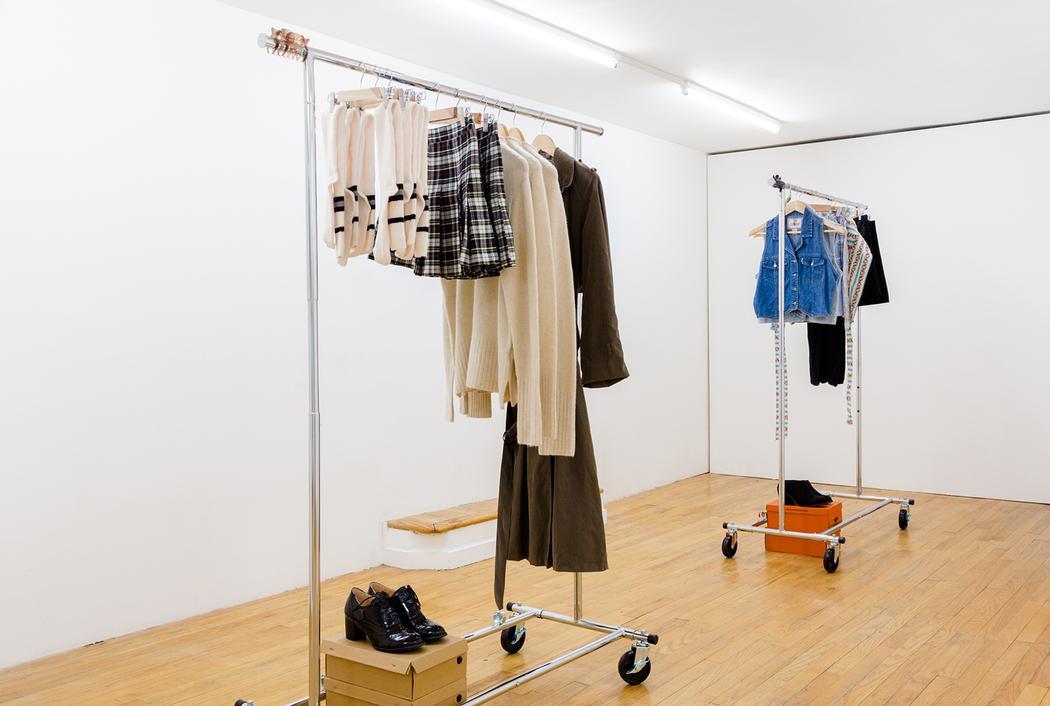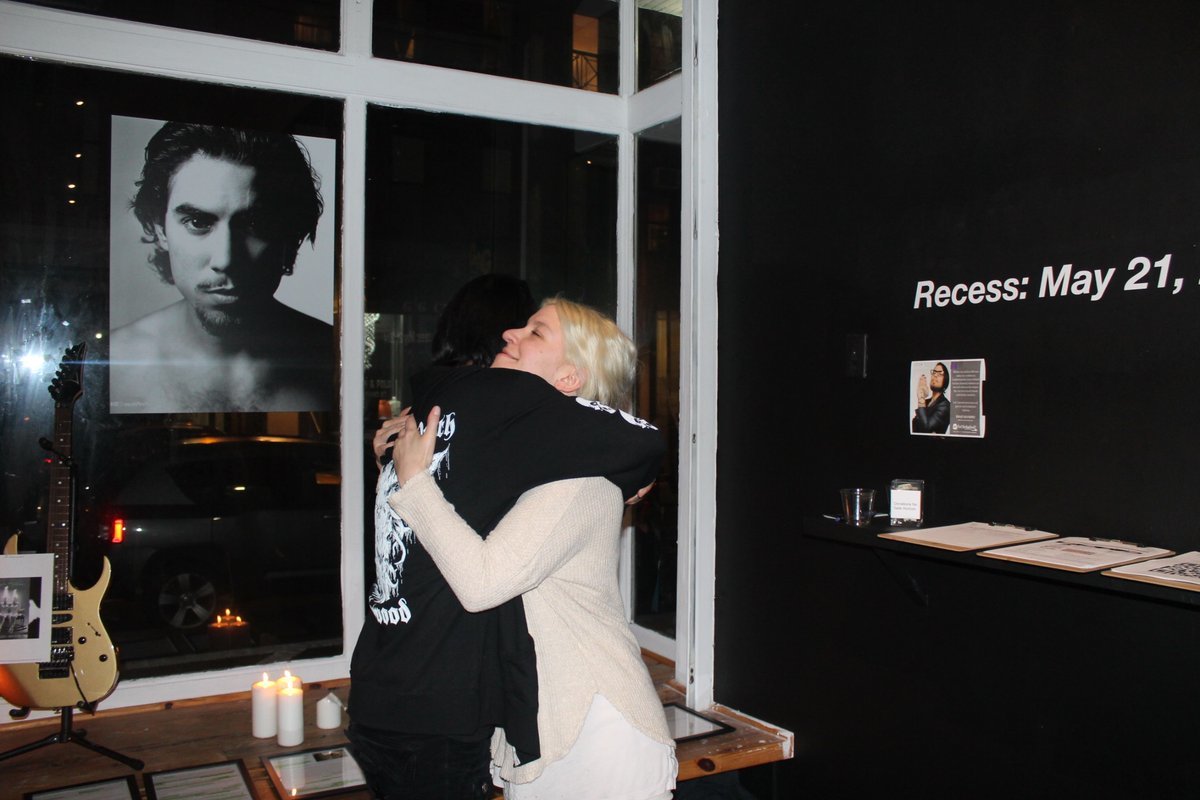A lot of artists are inspired by pop culture, but for New York based creative Am Schmidt, fame is the muse and the medium. Her pieces are tangles of familiar moments, drawn out, rearranged and put back together as strange and poignant meditations on the people and characters who fascinate us. A recent show saw her present racks outfits inspired by Rachel Green’s looks on Friends as distinct sculptural works. Before that, she filmed a shot-by-shot remake of Dirty Dancing, starring only her. Once she hired a professional impersonator of Sex and the City‘s Charlotte York to provide tours of MoMA. Now, in perhaps her most personal and ambitious effort yet, she has created a multi-part series around the myth, the man, Dave Navarro. She’s a big fan.
Inspired by a chance sighting of him while installing a show three years ago, she created an installation dedicated to his biography and personal tastes. The musician found out about it on social media, and has since been in touch with her, adding another level of wonky reality to the piece.
Not surprisingly, her work is very funny, but it’s also more textural than you’d assume a study of Jennifer Aniston’s denim vests or Dave Navarro’s contemporary art collection could be. She is not only exploring her own genuine love of these modern icons, but also pressing the viewer to challenge what they consider worthy of being a high art subject. By elevating these pieces of pop to something more intellectual, she not only plays with perspective, but also encourages the viewer to not be constrained by their own sense of intellectualism.
Let’s start with your recent show, an installation about the style of Rachel Green. How did that project come about?
One of the stages of preparation for my shot-for-shot remake of Dirty Dancing was gathering the wardrobe. I did all my shopping online for the sake of time and bought things that looked as similar as I could find to the outfits Baby, the female lead, wears in the original.
During the making of my movie, I set up a garment rack in the hall of the apartment I was staying in at the time. Having it out in plain sight and separate from my personal clothing was initially a way to keep tabs on what I had purchased, what had arrived, what I was waiting for, what I still had to purchase.
I took this garment rack and wardrobe with me to my second summer at the Bard MFA program. I had it set up in my studio for the entire summer, sitting across the room from me. Seeing it outside of a cramped apartment setting and in an empty room with space around it, I fell in love with it, aesthetically. For a time, I referred to it as a sculpture, but it doesn’t make sense as a sculpture, it’s an artefact for the movie I made.
During a studio visit, artist and Bard faculty member Kevin Everson told me that on real film sets, there are always at least two of everything for wardrobes. Hearing this gave me the idea to do a separate wardrobe work series that displayed the outfits of a different character from a different movie or show, one which I was not remaking nor ever planned to remake. I fell in love with the idea immediately. And my first thought to myself as a possible stand-in character for this idea was Rachel Green from Friends.
Rachel was obviously the fashion focused one, how did you select the looks to feature?
I chose outfits simply by ones that strike a chord with me. I’m not interested in having a show for which I collect and exhibit all of Rachel’s wardrobes. All the outfits Rachel ever wore are already there for the world to see in the TV show itself, on the internet, on Netflix. Me having to make choices of which wardrobes I want to recreate makes them discrete sculptures, as opposed to being one big indexical installation or set. These works are not a set. They are a series, but each work is distinctly its own work.
It just so happened that all the outfits I chose are from Season 1, which is the most ubiquitous “90s Rachel” look of all the Rachel looks.

You mentioned your Dirty Dancing project before — also a reflection on pop culture — do you see the works as linked?
Yes. My work has always involved a kind of channeling, a reference, to pop culture. I’m taken with things that get left behind. A sentence from my currently-in-progress Bard MFA thesis statement is, “I was a spiritual medium for the branded world.”
Tell me more about that idea of the “branded world,” do you see your work as deconstructing pop culture?
My intuitive answer is that I’m not deconstructing pop culture: it’s more about levelling art, and less about doing something to pop culture I’m not shattering any boundaries, but I am interested in quietly asserting that Rachel Green or Dave Navarro or whatever is each a factor in my art. I am not battling anything or trying to be coy. My work is not me positing a challenge. My work is me asserting that the factors and referents around me are on as equal a playing field for consideration as anything else in the canon of art.
Just to pause on Dave Navarro, your new show is about him, I heard he stopped by.
He attended the first reception after paying an impromptu visit two days prior while I was alone at Recess (the gallery) installing, which he semi-coordinated-slash-announced to me via Twitter DM moments before arriving. He gave the impression that he’s definitely into the show. And we gushed over some of our mutual favourites in his art collection, as he scrolled through his phone to show me a recent purchase.

Discussing art with your art subject in you art show about him seems like a very “full circle” moment.
While my initial aim of summoning his celebrity transcended the mere physical realm, this manifestation so early in the show did cause the focus to evolve. Furthering the early idea to re-create artworks that appear in his home on Cribs, I began recreating works in his collection at large. This has involved extensive research of his Instagram account and articles showing images of his homes over time. I still have a lot of research to do.
So to be clear, now you’re remaking pieces of art he had personally bought.
It’s not a serial recreation of all the works he owns, but more a rumination on his art tastes. I’ll inform him of these works as I complete them, because if I could ever get him to purchase one of these works — of a work he already owns — it would poetically fulfil the fan-of-the-fan circuit that was activated when he initially acknowledged the show on Twitter.
A post shared by Dave Navarro (@davenavarro) on Apr 27, 2017 at 6:35pm PDT
How has it been creating work about a real person, who as Dave did may discover and engage with the work, rather than a character?
Much, much harder. Have to strike a balance between being proactive enough to possibly get the person’s attention, and being not so pushy that you freak them out. It actually felt a lot like the first stages of dating. Maybe more like middle school dating, when you’ve worked up the courage to attempt interacting with one of the most enigmatic and charismatic people, and you’re screaming into your pillow when you get confirmation that they merely know your name.
It’s also hard to make a celebrity see it as art and not fandom. This show completely involves my earnest fandom. But my earnest fandom was not the point, was not the impetus for the show.
Credits
Text Wendy Syfret
